ARBE1102: Construction Ecology Decision Making Project - Hobart
VerifiedAdded on 2020/11/30
|12
|4545
|81
Project
AI Summary
This project, for ARBE1102, focuses on a decision-making process for selecting sustainable interior building materials for a townhouse development in Hobart, Tasmania. The scenario involves a developer seeking an 'attractive list of eco and healthy' materials, prompting an evaluation of concrete blocks, gypsum board, and stainless steel. The project considers Hobart's climate (Zone 7), client requirements, and the need for low-cost, locally sourced, and recyclable materials to minimize environmental impact. The analysis includes embodied carbon, recycled content, life expectancy, and health impacts, using a decision-making framework to assess the ideal material options, considering factors such as thermal conductivity, wind conditions and the overall goal of aligning with the developer's 'green building' marketing strategy. The project highlights the importance of sustainability, reducing carbon emissions, and promoting eco-friendly construction practices.
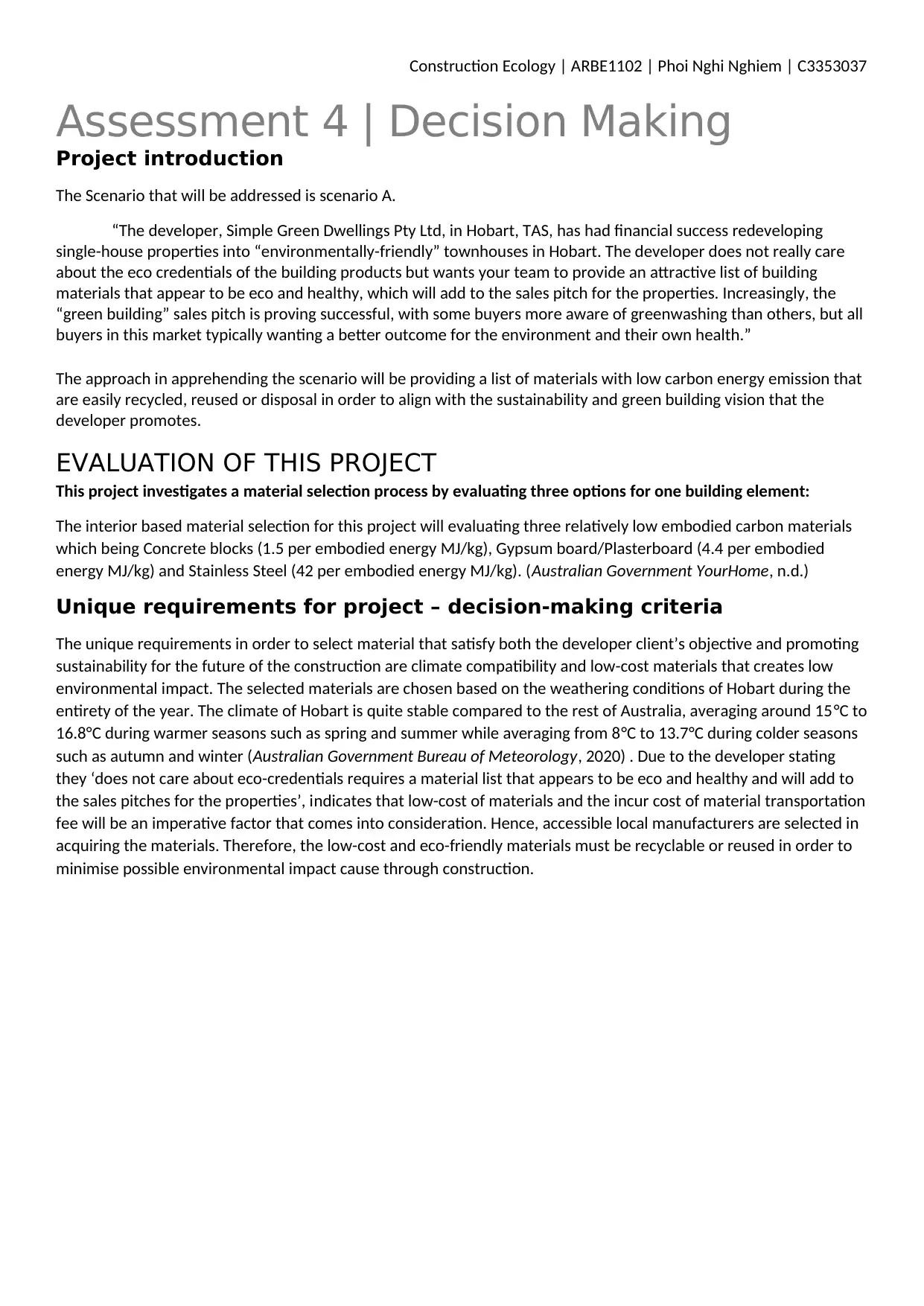
Construction Ecology | ARBE1102 | Phoi Nghi Nghiem | C3353037
Assessment 4 | Decision Making
Project introduction
The Scenario that will be addressed is scenario A.
“The developer, Simple Green Dwellings Pty Ltd, in Hobart, TAS, has had financial success redeveloping
single-house properties into “environmentally-friendly” townhouses in Hobart. The developer does not really care
about the eco credentials of the building products but wants your team to provide an attractive list of building
materials that appear to be eco and healthy, which will add to the sales pitch for the properties. Increasingly, the
“green building” sales pitch is proving successful, with some buyers more aware of greenwashing than others, but all
buyers in this market typically wanting a better outcome for the environment and their own health.”
The approach in apprehending the scenario will be providing a list of materials with low carbon energy emission that
are easily recycled, reused or disposal in order to align with the sustainability and green building vision that the
developer promotes.
EVALUATION OF THIS PROJECT
This project investigates a material selection process by evaluating three options for one building element:
The interior based material selection for this project will evaluating three relatively low embodied carbon materials
which being Concrete blocks (1.5 per embodied energy MJ/kg), Gypsum board/Plasterboard (4.4 per embodied
energy MJ/kg) and Stainless Steel (42 per embodied energy MJ/kg). (Australian Government YourHome, n.d.)
Unique requirements for project – decision-making criteria
The unique requirements in order to select material that satisfy both the developer client’s objective and promoting
sustainability for the future of the construction are climate compatibility and low-cost materials that creates low
environmental impact. The selected materials are chosen based on the weathering conditions of Hobart during the
entirety of the year. The climate of Hobart is quite stable compared to the rest of Australia, averaging around 15°C to
16.8°C during warmer seasons such as spring and summer while averaging from 8°C to 13.7°C during colder seasons
such as autumn and winter (Australian Government Bureau of Meteorology, 2020) . Due to the developer stating
they ‘does not care about eco-credentials requires a material list that appears to be eco and healthy and will add to
the sales pitches for the properties’, indicates that low-cost of materials and the incur cost of material transportation
fee will be an imperative factor that comes into consideration. Hence, accessible local manufacturers are selected in
acquiring the materials. Therefore, the low-cost and eco-friendly materials must be recyclable or reused in order to
minimise possible environmental impact cause through construction.
Assessment 4 | Decision Making
Project introduction
The Scenario that will be addressed is scenario A.
“The developer, Simple Green Dwellings Pty Ltd, in Hobart, TAS, has had financial success redeveloping
single-house properties into “environmentally-friendly” townhouses in Hobart. The developer does not really care
about the eco credentials of the building products but wants your team to provide an attractive list of building
materials that appear to be eco and healthy, which will add to the sales pitch for the properties. Increasingly, the
“green building” sales pitch is proving successful, with some buyers more aware of greenwashing than others, but all
buyers in this market typically wanting a better outcome for the environment and their own health.”
The approach in apprehending the scenario will be providing a list of materials with low carbon energy emission that
are easily recycled, reused or disposal in order to align with the sustainability and green building vision that the
developer promotes.
EVALUATION OF THIS PROJECT
This project investigates a material selection process by evaluating three options for one building element:
The interior based material selection for this project will evaluating three relatively low embodied carbon materials
which being Concrete blocks (1.5 per embodied energy MJ/kg), Gypsum board/Plasterboard (4.4 per embodied
energy MJ/kg) and Stainless Steel (42 per embodied energy MJ/kg). (Australian Government YourHome, n.d.)
Unique requirements for project – decision-making criteria
The unique requirements in order to select material that satisfy both the developer client’s objective and promoting
sustainability for the future of the construction are climate compatibility and low-cost materials that creates low
environmental impact. The selected materials are chosen based on the weathering conditions of Hobart during the
entirety of the year. The climate of Hobart is quite stable compared to the rest of Australia, averaging around 15°C to
16.8°C during warmer seasons such as spring and summer while averaging from 8°C to 13.7°C during colder seasons
such as autumn and winter (Australian Government Bureau of Meteorology, 2020) . Due to the developer stating
they ‘does not care about eco-credentials requires a material list that appears to be eco and healthy and will add to
the sales pitches for the properties’, indicates that low-cost of materials and the incur cost of material transportation
fee will be an imperative factor that comes into consideration. Hence, accessible local manufacturers are selected in
acquiring the materials. Therefore, the low-cost and eco-friendly materials must be recyclable or reused in order to
minimise possible environmental impact cause through construction.
Paraphrase This Document
Need a fresh take? Get an instant paraphrase of this document with our AI Paraphraser
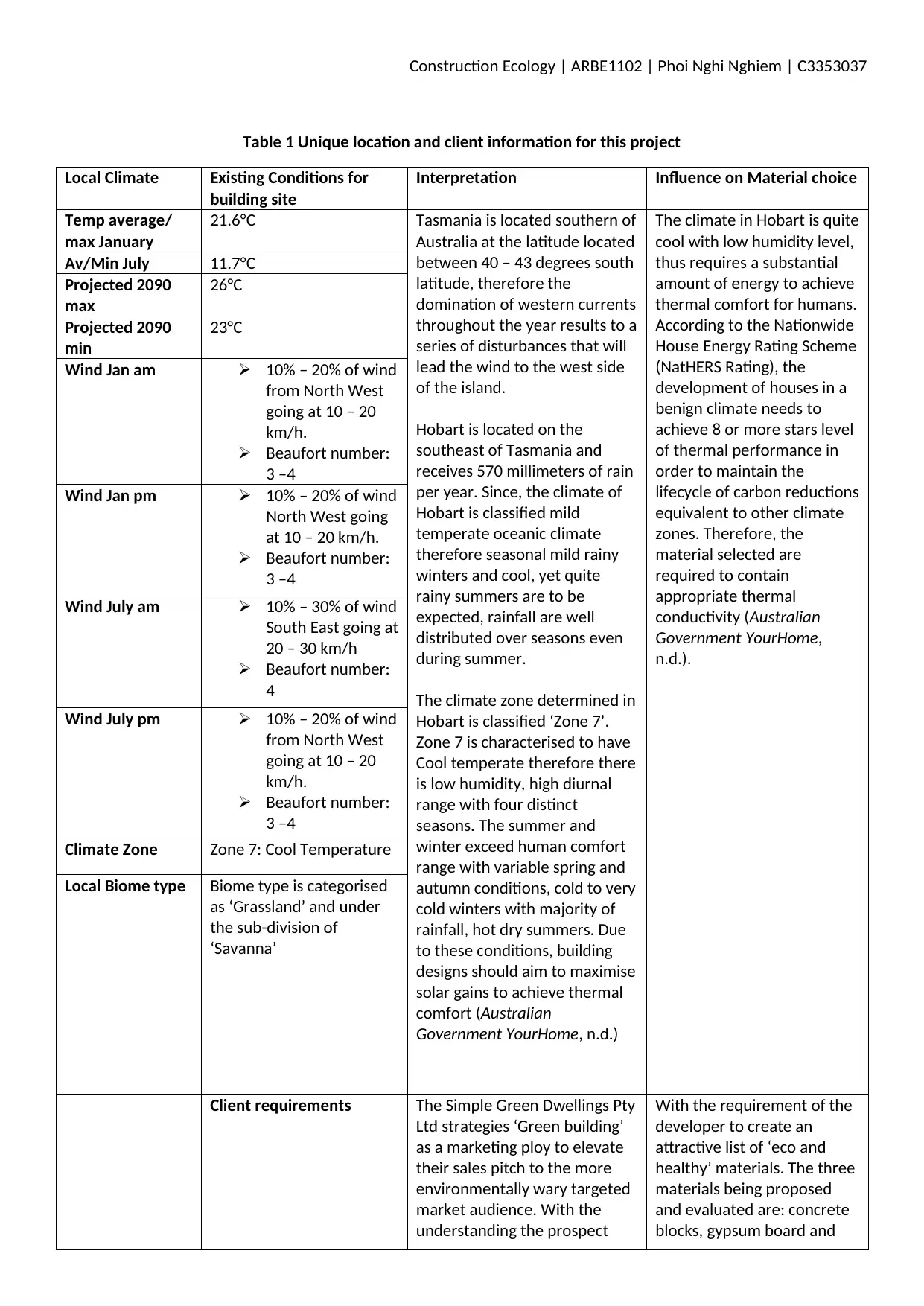
Construction Ecology | ARBE1102 | Phoi Nghi Nghiem | C3353037
Table 1 Unique location and client information for this project
Local Climate Existing Conditions for
building site
Interpretation Influence on Material choice
Temp average/
max January
21.6°C Tasmania is located southern of
Australia at the latitude located
between 40 – 43 degrees south
latitude, therefore the
domination of western currents
throughout the year results to a
series of disturbances that will
lead the wind to the west side
of the island.
Hobart is located on the
southeast of Tasmania and
receives 570 millimeters of rain
per year. Since, the climate of
Hobart is classified mild
temperate oceanic climate
therefore seasonal mild rainy
winters and cool, yet quite
rainy summers are to be
expected, rainfall are well
distributed over seasons even
during summer.
The climate zone determined in
Hobart is classified ‘Zone 7’.
Zone 7 is characterised to have
Cool temperate therefore there
is low humidity, high diurnal
range with four distinct
seasons. The summer and
winter exceed human comfort
range with variable spring and
autumn conditions, cold to very
cold winters with majority of
rainfall, hot dry summers. Due
to these conditions, building
designs should aim to maximise
solar gains to achieve thermal
comfort (Australian
Government YourHome, n.d.)
The climate in Hobart is quite
cool with low humidity level,
thus requires a substantial
amount of energy to achieve
thermal comfort for humans.
According to the Nationwide
House Energy Rating Scheme
(NatHERS Rating), the
development of houses in a
benign climate needs to
achieve 8 or more stars level
of thermal performance in
order to maintain the
lifecycle of carbon reductions
equivalent to other climate
zones. Therefore, the
material selected are
required to contain
appropriate thermal
conductivity (Australian
Government YourHome,
n.d.).
Av/Min July 11.7°C
Projected 2090
max
26°C
Projected 2090
min
23°C
Wind Jan am 10% – 20% of wind
from North West
going at 10 – 20
km/h.
Beaufort number:
3 –4
Wind Jan pm 10% – 20% of wind
North West going
at 10 – 20 km/h.
Beaufort number:
3 –4
Wind July am 10% – 30% of wind
South East going at
20 – 30 km/h
Beaufort number:
4
Wind July pm 10% – 20% of wind
from North West
going at 10 – 20
km/h.
Beaufort number:
3 –4
Climate Zone Zone 7: Cool Temperature
Local Biome type Biome type is categorised
as ‘Grassland’ and under
the sub-division of
‘Savanna’
Client requirements The Simple Green Dwellings Pty
Ltd strategies ‘Green building’
as a marketing ploy to elevate
their sales pitch to the more
environmentally wary targeted
market audience. With the
understanding the prospect
With the requirement of the
developer to create an
attractive list of ‘eco and
healthy’ materials. The three
materials being proposed
and evaluated are: concrete
blocks, gypsum board and
Table 1 Unique location and client information for this project
Local Climate Existing Conditions for
building site
Interpretation Influence on Material choice
Temp average/
max January
21.6°C Tasmania is located southern of
Australia at the latitude located
between 40 – 43 degrees south
latitude, therefore the
domination of western currents
throughout the year results to a
series of disturbances that will
lead the wind to the west side
of the island.
Hobart is located on the
southeast of Tasmania and
receives 570 millimeters of rain
per year. Since, the climate of
Hobart is classified mild
temperate oceanic climate
therefore seasonal mild rainy
winters and cool, yet quite
rainy summers are to be
expected, rainfall are well
distributed over seasons even
during summer.
The climate zone determined in
Hobart is classified ‘Zone 7’.
Zone 7 is characterised to have
Cool temperate therefore there
is low humidity, high diurnal
range with four distinct
seasons. The summer and
winter exceed human comfort
range with variable spring and
autumn conditions, cold to very
cold winters with majority of
rainfall, hot dry summers. Due
to these conditions, building
designs should aim to maximise
solar gains to achieve thermal
comfort (Australian
Government YourHome, n.d.)
The climate in Hobart is quite
cool with low humidity level,
thus requires a substantial
amount of energy to achieve
thermal comfort for humans.
According to the Nationwide
House Energy Rating Scheme
(NatHERS Rating), the
development of houses in a
benign climate needs to
achieve 8 or more stars level
of thermal performance in
order to maintain the
lifecycle of carbon reductions
equivalent to other climate
zones. Therefore, the
material selected are
required to contain
appropriate thermal
conductivity (Australian
Government YourHome,
n.d.).
Av/Min July 11.7°C
Projected 2090
max
26°C
Projected 2090
min
23°C
Wind Jan am 10% – 20% of wind
from North West
going at 10 – 20
km/h.
Beaufort number:
3 –4
Wind Jan pm 10% – 20% of wind
North West going
at 10 – 20 km/h.
Beaufort number:
3 –4
Wind July am 10% – 30% of wind
South East going at
20 – 30 km/h
Beaufort number:
4
Wind July pm 10% – 20% of wind
from North West
going at 10 – 20
km/h.
Beaufort number:
3 –4
Climate Zone Zone 7: Cool Temperature
Local Biome type Biome type is categorised
as ‘Grassland’ and under
the sub-division of
‘Savanna’
Client requirements The Simple Green Dwellings Pty
Ltd strategies ‘Green building’
as a marketing ploy to elevate
their sales pitch to the more
environmentally wary targeted
market audience. With the
understanding the prospect
With the requirement of the
developer to create an
attractive list of ‘eco and
healthy’ materials. The three
materials being proposed
and evaluated are: concrete
blocks, gypsum board and
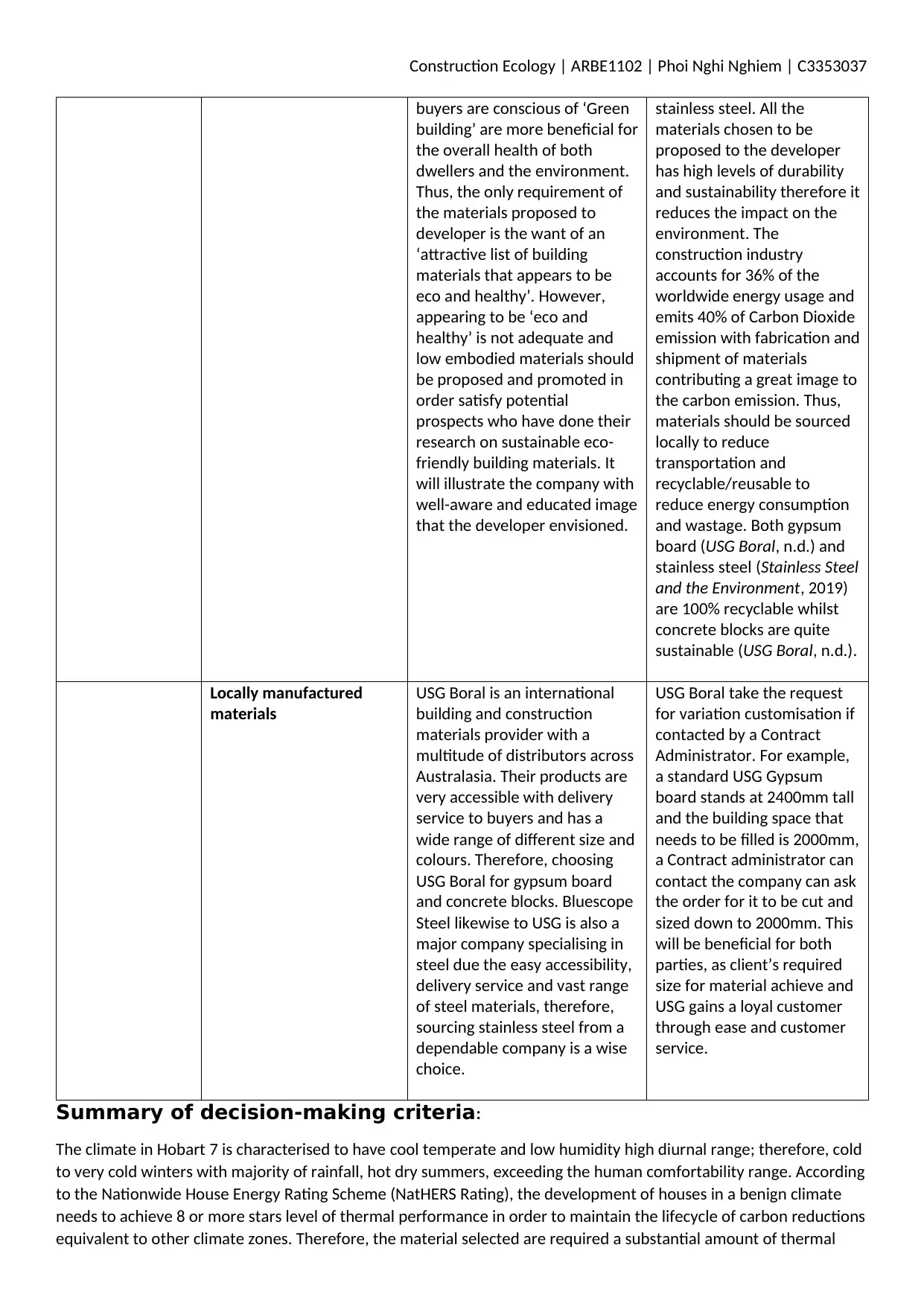
Construction Ecology | ARBE1102 | Phoi Nghi Nghiem | C3353037
buyers are conscious of ‘Green
building’ are more beneficial for
the overall health of both
dwellers and the environment.
Thus, the only requirement of
the materials proposed to
developer is the want of an
‘attractive list of building
materials that appears to be
eco and healthy’. However,
appearing to be ‘eco and
healthy’ is not adequate and
low embodied materials should
be proposed and promoted in
order satisfy potential
prospects who have done their
research on sustainable eco-
friendly building materials. It
will illustrate the company with
well-aware and educated image
that the developer envisioned.
stainless steel. All the
materials chosen to be
proposed to the developer
has high levels of durability
and sustainability therefore it
reduces the impact on the
environment. The
construction industry
accounts for 36% of the
worldwide energy usage and
emits 40% of Carbon Dioxide
emission with fabrication and
shipment of materials
contributing a great image to
the carbon emission. Thus,
materials should be sourced
locally to reduce
transportation and
recyclable/reusable to
reduce energy consumption
and wastage. Both gypsum
board (USG Boral, n.d.) and
stainless steel (Stainless Steel
and the Environment, 2019)
are 100% recyclable whilst
concrete blocks are quite
sustainable (USG Boral, n.d.).
Locally manufactured
materials
USG Boral is an international
building and construction
materials provider with a
multitude of distributors across
Australasia. Their products are
very accessible with delivery
service to buyers and has a
wide range of different size and
colours. Therefore, choosing
USG Boral for gypsum board
and concrete blocks. Bluescope
Steel likewise to USG is also a
major company specialising in
steel due the easy accessibility,
delivery service and vast range
of steel materials, therefore,
sourcing stainless steel from a
dependable company is a wise
choice.
USG Boral take the request
for variation customisation if
contacted by a Contract
Administrator. For example,
a standard USG Gypsum
board stands at 2400mm tall
and the building space that
needs to be filled is 2000mm,
a Contract administrator can
contact the company can ask
the order for it to be cut and
sized down to 2000mm. This
will be beneficial for both
parties, as client’s required
size for material achieve and
USG gains a loyal customer
through ease and customer
service.
Summary of decision-making criteria:
The climate in Hobart 7 is characterised to have cool temperate and low humidity high diurnal range; therefore, cold
to very cold winters with majority of rainfall, hot dry summers, exceeding the human comfortability range. According
to the Nationwide House Energy Rating Scheme (NatHERS Rating), the development of houses in a benign climate
needs to achieve 8 or more stars level of thermal performance in order to maintain the lifecycle of carbon reductions
equivalent to other climate zones. Therefore, the material selected are required a substantial amount of thermal
buyers are conscious of ‘Green
building’ are more beneficial for
the overall health of both
dwellers and the environment.
Thus, the only requirement of
the materials proposed to
developer is the want of an
‘attractive list of building
materials that appears to be
eco and healthy’. However,
appearing to be ‘eco and
healthy’ is not adequate and
low embodied materials should
be proposed and promoted in
order satisfy potential
prospects who have done their
research on sustainable eco-
friendly building materials. It
will illustrate the company with
well-aware and educated image
that the developer envisioned.
stainless steel. All the
materials chosen to be
proposed to the developer
has high levels of durability
and sustainability therefore it
reduces the impact on the
environment. The
construction industry
accounts for 36% of the
worldwide energy usage and
emits 40% of Carbon Dioxide
emission with fabrication and
shipment of materials
contributing a great image to
the carbon emission. Thus,
materials should be sourced
locally to reduce
transportation and
recyclable/reusable to
reduce energy consumption
and wastage. Both gypsum
board (USG Boral, n.d.) and
stainless steel (Stainless Steel
and the Environment, 2019)
are 100% recyclable whilst
concrete blocks are quite
sustainable (USG Boral, n.d.).
Locally manufactured
materials
USG Boral is an international
building and construction
materials provider with a
multitude of distributors across
Australasia. Their products are
very accessible with delivery
service to buyers and has a
wide range of different size and
colours. Therefore, choosing
USG Boral for gypsum board
and concrete blocks. Bluescope
Steel likewise to USG is also a
major company specialising in
steel due the easy accessibility,
delivery service and vast range
of steel materials, therefore,
sourcing stainless steel from a
dependable company is a wise
choice.
USG Boral take the request
for variation customisation if
contacted by a Contract
Administrator. For example,
a standard USG Gypsum
board stands at 2400mm tall
and the building space that
needs to be filled is 2000mm,
a Contract administrator can
contact the company can ask
the order for it to be cut and
sized down to 2000mm. This
will be beneficial for both
parties, as client’s required
size for material achieve and
USG gains a loyal customer
through ease and customer
service.
Summary of decision-making criteria:
The climate in Hobart 7 is characterised to have cool temperate and low humidity high diurnal range; therefore, cold
to very cold winters with majority of rainfall, hot dry summers, exceeding the human comfortability range. According
to the Nationwide House Energy Rating Scheme (NatHERS Rating), the development of houses in a benign climate
needs to achieve 8 or more stars level of thermal performance in order to maintain the lifecycle of carbon reductions
equivalent to other climate zones. Therefore, the material selected are required a substantial amount of thermal
⊘ This is a preview!⊘
Do you want full access?
Subscribe today to unlock all pages.

Trusted by 1+ million students worldwide
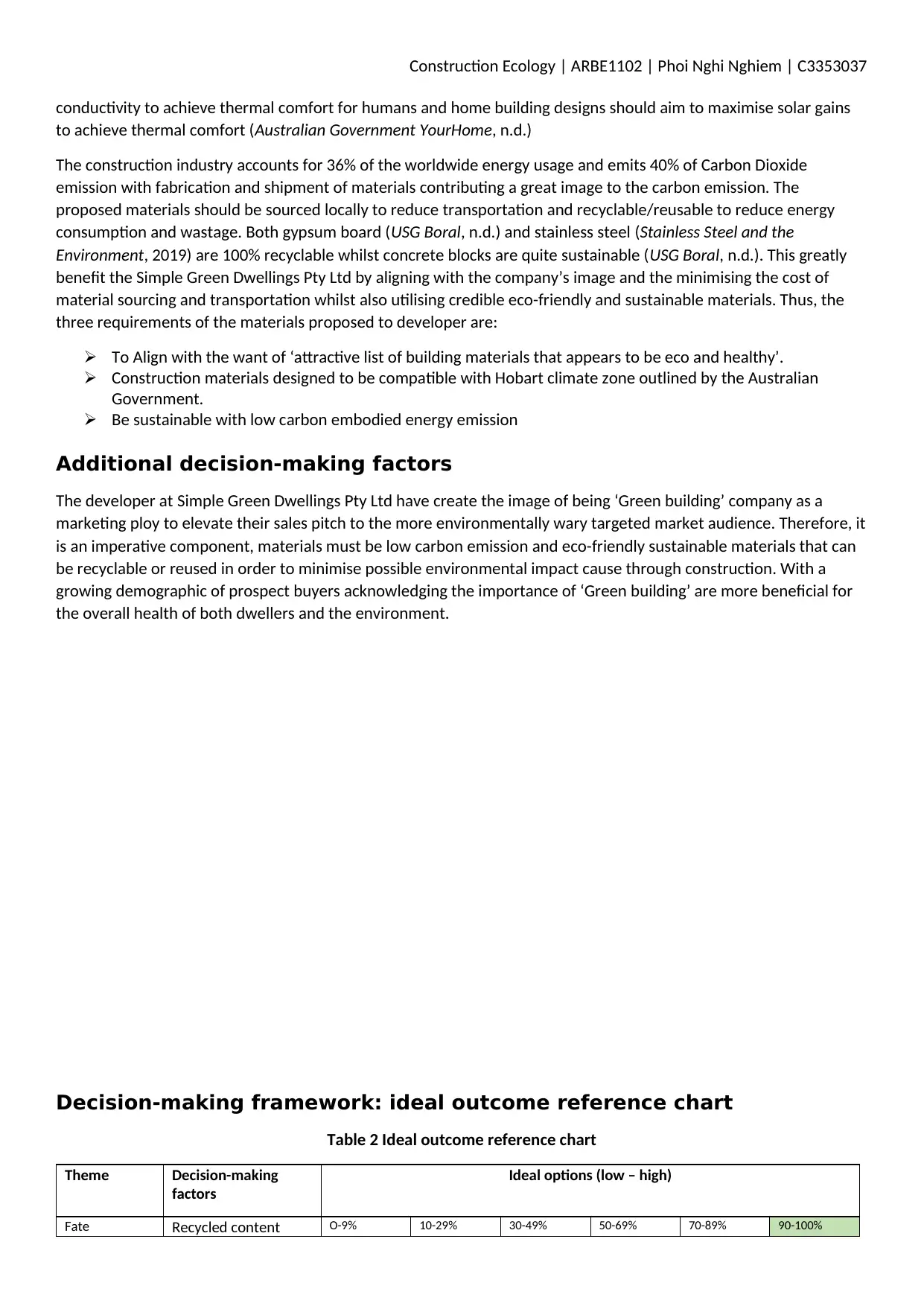
Construction Ecology | ARBE1102 | Phoi Nghi Nghiem | C3353037
conductivity to achieve thermal comfort for humans and home building designs should aim to maximise solar gains
to achieve thermal comfort (Australian Government YourHome, n.d.)
The construction industry accounts for 36% of the worldwide energy usage and emits 40% of Carbon Dioxide
emission with fabrication and shipment of materials contributing a great image to the carbon emission. The
proposed materials should be sourced locally to reduce transportation and recyclable/reusable to reduce energy
consumption and wastage. Both gypsum board (USG Boral, n.d.) and stainless steel (Stainless Steel and the
Environment, 2019) are 100% recyclable whilst concrete blocks are quite sustainable (USG Boral, n.d.). This greatly
benefit the Simple Green Dwellings Pty Ltd by aligning with the company’s image and the minimising the cost of
material sourcing and transportation whilst also utilising credible eco-friendly and sustainable materials. Thus, the
three requirements of the materials proposed to developer are:
To Align with the want of ‘attractive list of building materials that appears to be eco and healthy’.
Construction materials designed to be compatible with Hobart climate zone outlined by the Australian
Government.
Be sustainable with low carbon embodied energy emission
Additional decision-making factors
The developer at Simple Green Dwellings Pty Ltd have create the image of being ‘Green building’ company as a
marketing ploy to elevate their sales pitch to the more environmentally wary targeted market audience. Therefore, it
is an imperative component, materials must be low carbon emission and eco-friendly sustainable materials that can
be recyclable or reused in order to minimise possible environmental impact cause through construction. With a
growing demographic of prospect buyers acknowledging the importance of ‘Green building’ are more beneficial for
the overall health of both dwellers and the environment.
Decision-making framework: ideal outcome reference chart
Table 2 Ideal outcome reference chart
Theme Decision-making
factors
Ideal options (low – high)
Fate Recycled content O-9% 10-29% 30-49% 50-69% 70-89% 90-100%
conductivity to achieve thermal comfort for humans and home building designs should aim to maximise solar gains
to achieve thermal comfort (Australian Government YourHome, n.d.)
The construction industry accounts for 36% of the worldwide energy usage and emits 40% of Carbon Dioxide
emission with fabrication and shipment of materials contributing a great image to the carbon emission. The
proposed materials should be sourced locally to reduce transportation and recyclable/reusable to reduce energy
consumption and wastage. Both gypsum board (USG Boral, n.d.) and stainless steel (Stainless Steel and the
Environment, 2019) are 100% recyclable whilst concrete blocks are quite sustainable (USG Boral, n.d.). This greatly
benefit the Simple Green Dwellings Pty Ltd by aligning with the company’s image and the minimising the cost of
material sourcing and transportation whilst also utilising credible eco-friendly and sustainable materials. Thus, the
three requirements of the materials proposed to developer are:
To Align with the want of ‘attractive list of building materials that appears to be eco and healthy’.
Construction materials designed to be compatible with Hobart climate zone outlined by the Australian
Government.
Be sustainable with low carbon embodied energy emission
Additional decision-making factors
The developer at Simple Green Dwellings Pty Ltd have create the image of being ‘Green building’ company as a
marketing ploy to elevate their sales pitch to the more environmentally wary targeted market audience. Therefore, it
is an imperative component, materials must be low carbon emission and eco-friendly sustainable materials that can
be recyclable or reused in order to minimise possible environmental impact cause through construction. With a
growing demographic of prospect buyers acknowledging the importance of ‘Green building’ are more beneficial for
the overall health of both dwellers and the environment.
Decision-making framework: ideal outcome reference chart
Table 2 Ideal outcome reference chart
Theme Decision-making
factors
Ideal options (low – high)
Fate Recycled content O-9% 10-29% 30-49% 50-69% 70-89% 90-100%
Paraphrase This Document
Need a fresh take? Get an instant paraphrase of this document with our AI Paraphraser
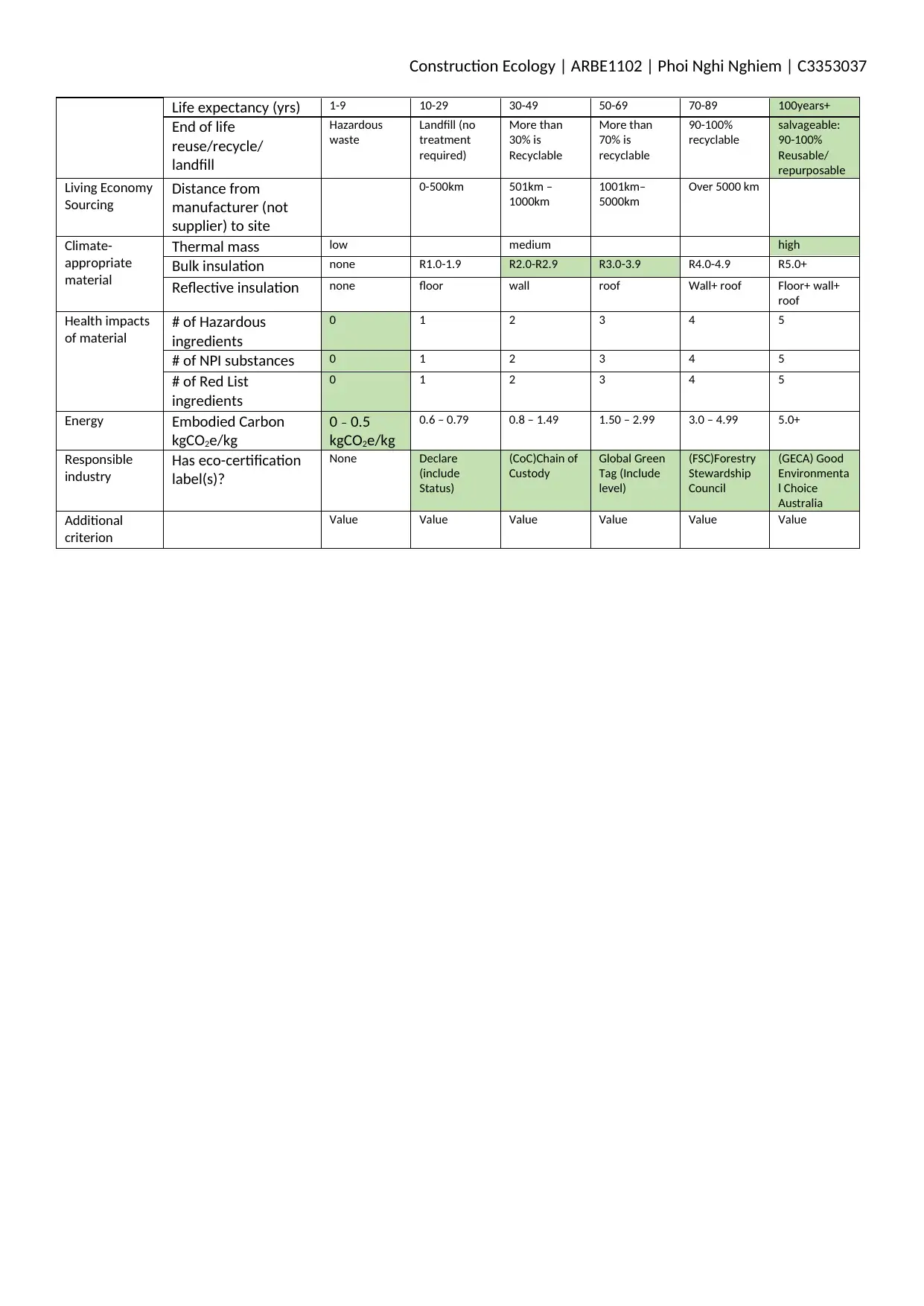
Construction Ecology | ARBE1102 | Phoi Nghi Nghiem | C3353037
Life expectancy (yrs) 1-9 10-29 30-49 50-69 70-89 100years+
End of life
reuse/recycle/
landfill
Hazardous
waste
Landfill (no
treatment
required)
More than
30% is
Recyclable
More than
70% is
recyclable
90-100%
recyclable
salvageable:
90-100%
Reusable/
repurposable
Living Economy
Sourcing
Distance from
manufacturer (not
supplier) to site
0-500km 501km –
1000km
1001km–
5000km
Over 5000 km
Climate-
appropriate
material
Thermal mass low medium high
Bulk insulation none R1.0-1.9 R2.0-R2.9 R3.0-3.9 R4.0-4.9 R5.0+
Reflective insulation none floor wall roof Wall+ roof Floor+ wall+
roof
Health impacts
of material
# of Hazardous
ingredients
0 1 2 3 4 5
# of NPI substances 0 1 2 3 4 5
# of Red List
ingredients
0 1 2 3 4 5
Energy Embodied Carbon
kgCO2e/kg
0 – 0.5
kgCO2e/kg
0.6 – 0.79 0.8 – 1.49 1.50 – 2.99 3.0 – 4.99 5.0+
Responsible
industry
Has eco-certification
label(s)?
None Declare
(include
Status)
(CoC)Chain of
Custody
Global Green
Tag (Include
level)
(FSC)Forestry
Stewardship
Council
(GECA) Good
Environmenta
l Choice
Australia
Additional
criterion
Value Value Value Value Value Value
Life expectancy (yrs) 1-9 10-29 30-49 50-69 70-89 100years+
End of life
reuse/recycle/
landfill
Hazardous
waste
Landfill (no
treatment
required)
More than
30% is
Recyclable
More than
70% is
recyclable
90-100%
recyclable
salvageable:
90-100%
Reusable/
repurposable
Living Economy
Sourcing
Distance from
manufacturer (not
supplier) to site
0-500km 501km –
1000km
1001km–
5000km
Over 5000 km
Climate-
appropriate
material
Thermal mass low medium high
Bulk insulation none R1.0-1.9 R2.0-R2.9 R3.0-3.9 R4.0-4.9 R5.0+
Reflective insulation none floor wall roof Wall+ roof Floor+ wall+
roof
Health impacts
of material
# of Hazardous
ingredients
0 1 2 3 4 5
# of NPI substances 0 1 2 3 4 5
# of Red List
ingredients
0 1 2 3 4 5
Energy Embodied Carbon
kgCO2e/kg
0 – 0.5
kgCO2e/kg
0.6 – 0.79 0.8 – 1.49 1.50 – 2.99 3.0 – 4.99 5.0+
Responsible
industry
Has eco-certification
label(s)?
None Declare
(include
Status)
(CoC)Chain of
Custody
Global Green
Tag (Include
level)
(FSC)Forestry
Stewardship
Council
(GECA) Good
Environmenta
l Choice
Australia
Additional
criterion
Value Value Value Value Value Value
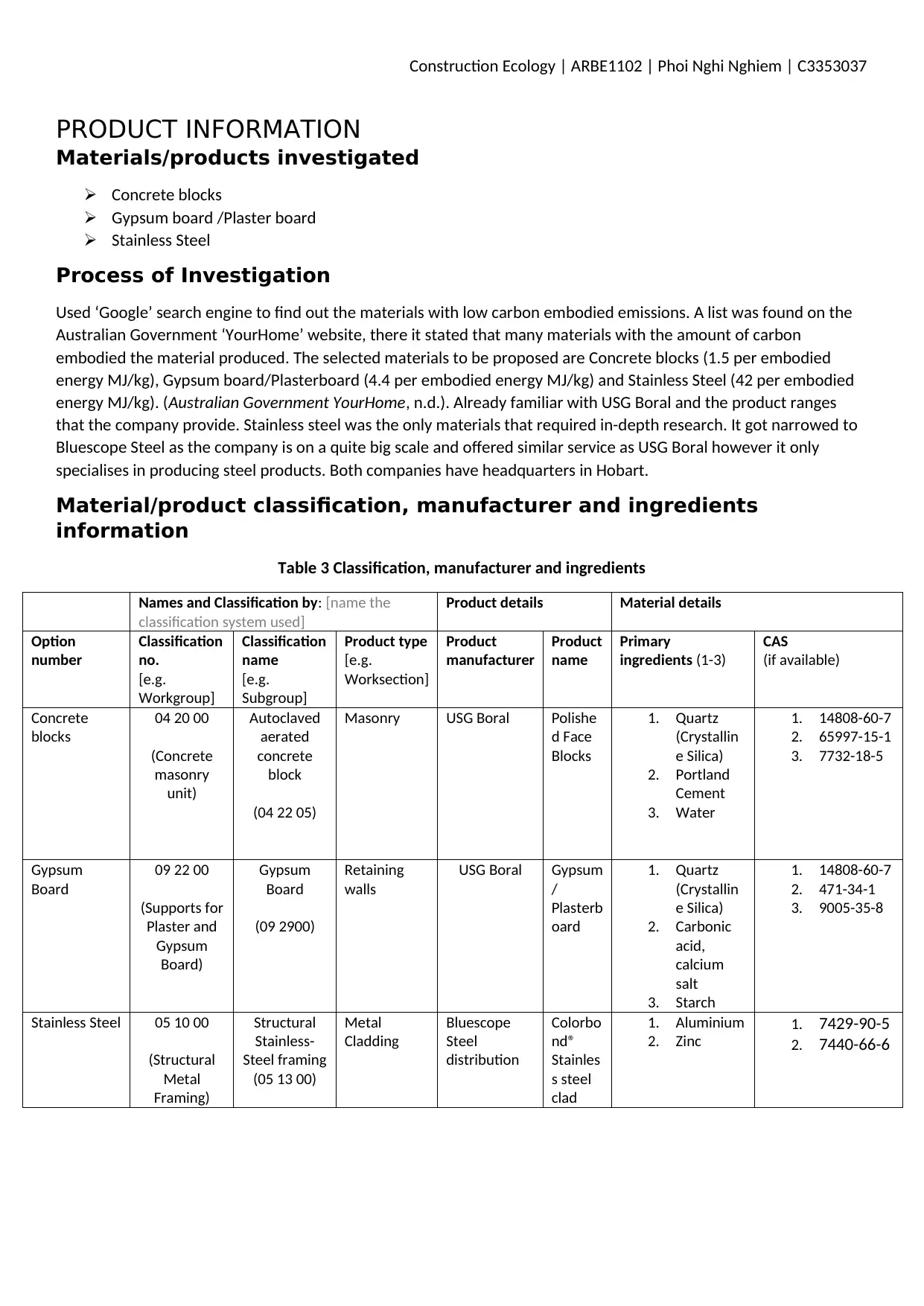
Construction Ecology | ARBE1102 | Phoi Nghi Nghiem | C3353037
PRODUCT INFORMATION
Materials/products investigated
Concrete blocks
Gypsum board /Plaster board
Stainless Steel
Process of Investigation
Used ‘Google’ search engine to find out the materials with low carbon embodied emissions. A list was found on the
Australian Government ‘YourHome’ website, there it stated that many materials with the amount of carbon
embodied the material produced. The selected materials to be proposed are Concrete blocks (1.5 per embodied
energy MJ/kg), Gypsum board/Plasterboard (4.4 per embodied energy MJ/kg) and Stainless Steel (42 per embodied
energy MJ/kg). (Australian Government YourHome, n.d.). Already familiar with USG Boral and the product ranges
that the company provide. Stainless steel was the only materials that required in-depth research. It got narrowed to
Bluescope Steel as the company is on a quite big scale and offered similar service as USG Boral however it only
specialises in producing steel products. Both companies have headquarters in Hobart.
Material/product classification, manufacturer and ingredients
information
Table 3 Classification, manufacturer and ingredients
Names and Classification by: [name the
classification system used]
Product details Material details
Option
number
Classification
no.
[e.g.
Workgroup]
Classification
name
[e.g.
Subgroup]
Product type
[e.g.
Worksection]
Product
manufacturer
Product
name
Primary
ingredients (1-3)
CAS
(if available)
Concrete
blocks
04 20 00
(Concrete
masonry
unit)
Autoclaved
aerated
concrete
block
(04 22 05)
Masonry USG Boral Polishe
d Face
Blocks
1. Quartz
(Crystallin
e Silica)
2. Portland
Cement
3. Water
1. 14808-60-7
2. 65997-15-1
3. 7732-18-5
Gypsum
Board
09 22 00
(Supports for
Plaster and
Gypsum
Board)
Gypsum
Board
(09 2900)
Retaining
walls
USG Boral Gypsum
/
Plasterb
oard
1. Quartz
(Crystallin
e Silica)
2. Carbonic
acid,
calcium
salt
3. Starch
1. 14808-60-7
2. 471-34-1
3. 9005-35-8
Stainless Steel 05 10 00
(Structural
Metal
Framing)
Structural
Stainless-
Steel framing
(05 13 00)
Metal
Cladding
Bluescope
Steel
distribution
Colorbo
nd®
Stainles
s steel
clad
1. Aluminium
2. Zinc
1. 7429-90-5
2. 7440-66-6
PRODUCT INFORMATION
Materials/products investigated
Concrete blocks
Gypsum board /Plaster board
Stainless Steel
Process of Investigation
Used ‘Google’ search engine to find out the materials with low carbon embodied emissions. A list was found on the
Australian Government ‘YourHome’ website, there it stated that many materials with the amount of carbon
embodied the material produced. The selected materials to be proposed are Concrete blocks (1.5 per embodied
energy MJ/kg), Gypsum board/Plasterboard (4.4 per embodied energy MJ/kg) and Stainless Steel (42 per embodied
energy MJ/kg). (Australian Government YourHome, n.d.). Already familiar with USG Boral and the product ranges
that the company provide. Stainless steel was the only materials that required in-depth research. It got narrowed to
Bluescope Steel as the company is on a quite big scale and offered similar service as USG Boral however it only
specialises in producing steel products. Both companies have headquarters in Hobart.
Material/product classification, manufacturer and ingredients
information
Table 3 Classification, manufacturer and ingredients
Names and Classification by: [name the
classification system used]
Product details Material details
Option
number
Classification
no.
[e.g.
Workgroup]
Classification
name
[e.g.
Subgroup]
Product type
[e.g.
Worksection]
Product
manufacturer
Product
name
Primary
ingredients (1-3)
CAS
(if available)
Concrete
blocks
04 20 00
(Concrete
masonry
unit)
Autoclaved
aerated
concrete
block
(04 22 05)
Masonry USG Boral Polishe
d Face
Blocks
1. Quartz
(Crystallin
e Silica)
2. Portland
Cement
3. Water
1. 14808-60-7
2. 65997-15-1
3. 7732-18-5
Gypsum
Board
09 22 00
(Supports for
Plaster and
Gypsum
Board)
Gypsum
Board
(09 2900)
Retaining
walls
USG Boral Gypsum
/
Plasterb
oard
1. Quartz
(Crystallin
e Silica)
2. Carbonic
acid,
calcium
salt
3. Starch
1. 14808-60-7
2. 471-34-1
3. 9005-35-8
Stainless Steel 05 10 00
(Structural
Metal
Framing)
Structural
Stainless-
Steel framing
(05 13 00)
Metal
Cladding
Bluescope
Steel
distribution
Colorbo
nd®
Stainles
s steel
clad
1. Aluminium
2. Zinc
1. 7429-90-5
2. 7440-66-6
⊘ This is a preview!⊘
Do you want full access?
Subscribe today to unlock all pages.

Trusted by 1+ million students worldwide
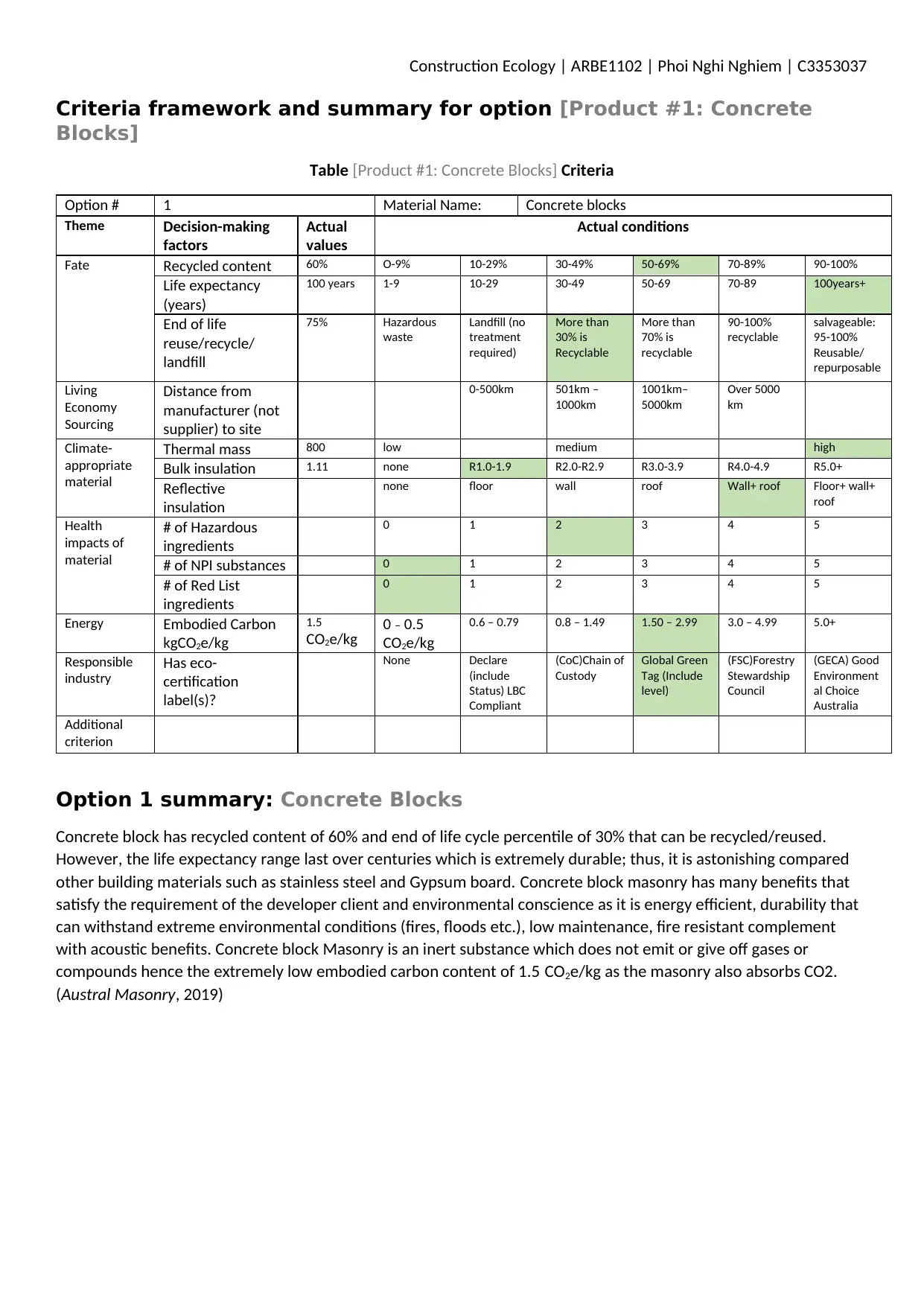
Construction Ecology | ARBE1102 | Phoi Nghi Nghiem | C3353037
Criteria framework and summary for option [Product #1: Concrete
Blocks]
Table [Product #1: Concrete Blocks] Criteria
Option # 1 Material Name: Concrete blocks
Theme Decision-making
factors
Actual
values
Actual conditions
Fate Recycled content 60% O-9% 10-29% 30-49% 50-69% 70-89% 90-100%
Life expectancy
(years)
100 years 1-9 10-29 30-49 50-69 70-89 100years+
End of life
reuse/recycle/
landfill
75% Hazardous
waste
Landfill (no
treatment
required)
More than
30% is
Recyclable
More than
70% is
recyclable
90-100%
recyclable
salvageable:
95-100%
Reusable/
repurposable
Living
Economy
Sourcing
Distance from
manufacturer (not
supplier) to site
0-500km 501km –
1000km
1001km–
5000km
Over 5000
km
Climate-
appropriate
material
Thermal mass 800 low medium high
Bulk insulation 1.11 none R1.0-1.9 R2.0-R2.9 R3.0-3.9 R4.0-4.9 R5.0+
Reflective
insulation
none floor wall roof Wall+ roof Floor+ wall+
roof
Health
impacts of
material
# of Hazardous
ingredients
0 1 2 3 4 5
# of NPI substances 0 1 2 3 4 5
# of Red List
ingredients
0 1 2 3 4 5
Energy Embodied Carbon
kgCO2e/kg
1.5
CO2e/kg 0 – 0.5
CO2e/kg
0.6 – 0.79 0.8 – 1.49 1.50 – 2.99 3.0 – 4.99 5.0+
Responsible
industry
Has eco-
certification
label(s)?
None Declare
(include
Status) LBC
Compliant
(CoC)Chain of
Custody
Global Green
Tag (Include
level)
(FSC)Forestry
Stewardship
Council
(GECA) Good
Environment
al Choice
Australia
Additional
criterion
Option 1 summary: Concrete Blocks
Concrete block has recycled content of 60% and end of life cycle percentile of 30% that can be recycled/reused.
However, the life expectancy range last over centuries which is extremely durable; thus, it is astonishing compared
other building materials such as stainless steel and Gypsum board. Concrete block masonry has many benefits that
satisfy the requirement of the developer client and environmental conscience as it is energy efficient, durability that
can withstand extreme environmental conditions (fires, floods etc.), low maintenance, fire resistant complement
with acoustic benefits. Concrete block Masonry is an inert substance which does not emit or give off gases or
compounds hence the extremely low embodied carbon content of 1.5 CO2e/kg as the masonry also absorbs CO2.
(Austral Masonry, 2019)
Criteria framework and summary for option [Product #1: Concrete
Blocks]
Table [Product #1: Concrete Blocks] Criteria
Option # 1 Material Name: Concrete blocks
Theme Decision-making
factors
Actual
values
Actual conditions
Fate Recycled content 60% O-9% 10-29% 30-49% 50-69% 70-89% 90-100%
Life expectancy
(years)
100 years 1-9 10-29 30-49 50-69 70-89 100years+
End of life
reuse/recycle/
landfill
75% Hazardous
waste
Landfill (no
treatment
required)
More than
30% is
Recyclable
More than
70% is
recyclable
90-100%
recyclable
salvageable:
95-100%
Reusable/
repurposable
Living
Economy
Sourcing
Distance from
manufacturer (not
supplier) to site
0-500km 501km –
1000km
1001km–
5000km
Over 5000
km
Climate-
appropriate
material
Thermal mass 800 low medium high
Bulk insulation 1.11 none R1.0-1.9 R2.0-R2.9 R3.0-3.9 R4.0-4.9 R5.0+
Reflective
insulation
none floor wall roof Wall+ roof Floor+ wall+
roof
Health
impacts of
material
# of Hazardous
ingredients
0 1 2 3 4 5
# of NPI substances 0 1 2 3 4 5
# of Red List
ingredients
0 1 2 3 4 5
Energy Embodied Carbon
kgCO2e/kg
1.5
CO2e/kg 0 – 0.5
CO2e/kg
0.6 – 0.79 0.8 – 1.49 1.50 – 2.99 3.0 – 4.99 5.0+
Responsible
industry
Has eco-
certification
label(s)?
None Declare
(include
Status) LBC
Compliant
(CoC)Chain of
Custody
Global Green
Tag (Include
level)
(FSC)Forestry
Stewardship
Council
(GECA) Good
Environment
al Choice
Australia
Additional
criterion
Option 1 summary: Concrete Blocks
Concrete block has recycled content of 60% and end of life cycle percentile of 30% that can be recycled/reused.
However, the life expectancy range last over centuries which is extremely durable; thus, it is astonishing compared
other building materials such as stainless steel and Gypsum board. Concrete block masonry has many benefits that
satisfy the requirement of the developer client and environmental conscience as it is energy efficient, durability that
can withstand extreme environmental conditions (fires, floods etc.), low maintenance, fire resistant complement
with acoustic benefits. Concrete block Masonry is an inert substance which does not emit or give off gases or
compounds hence the extremely low embodied carbon content of 1.5 CO2e/kg as the masonry also absorbs CO2.
(Austral Masonry, 2019)
Paraphrase This Document
Need a fresh take? Get an instant paraphrase of this document with our AI Paraphraser
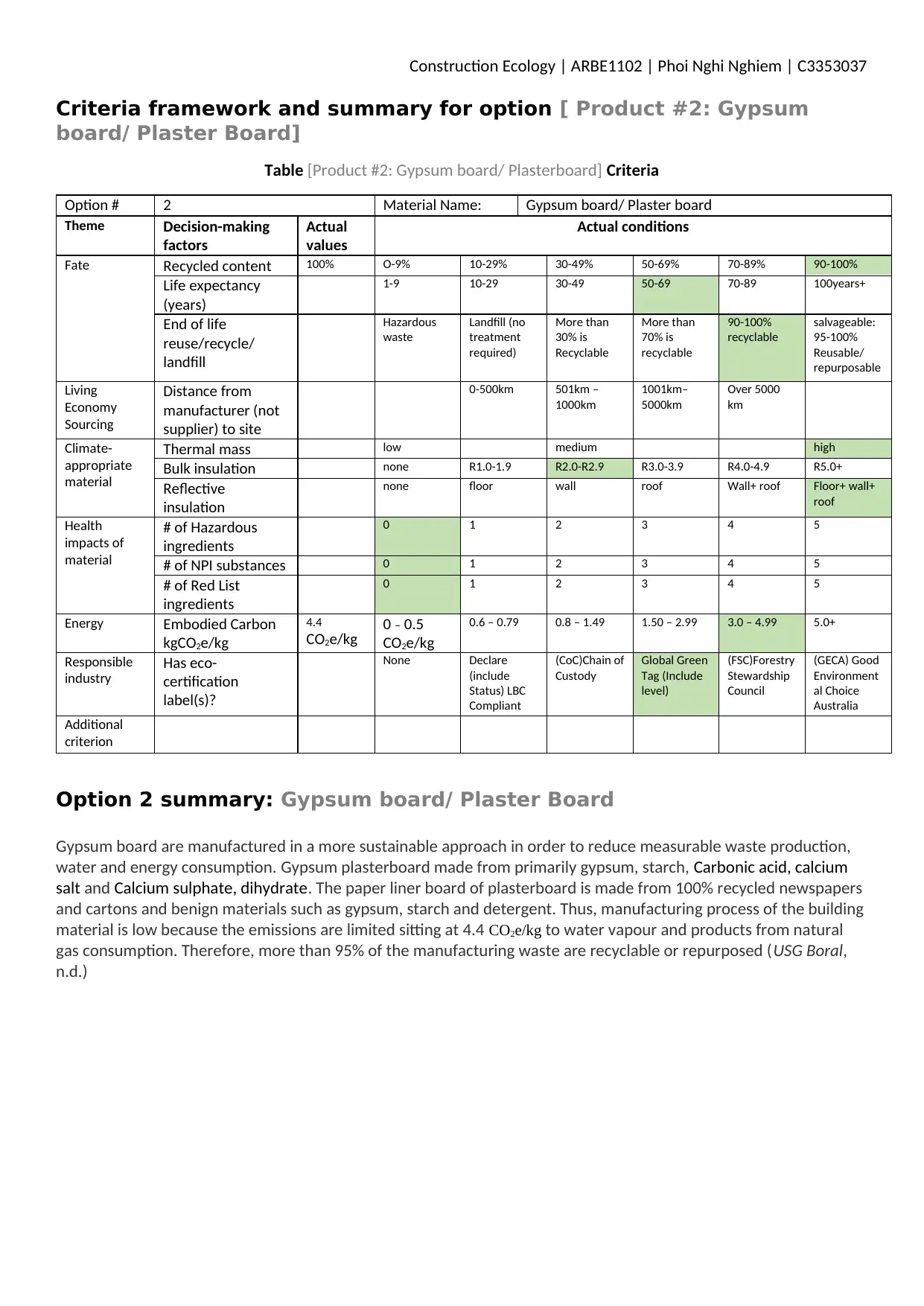
Construction Ecology | ARBE1102 | Phoi Nghi Nghiem | C3353037
Criteria framework and summary for option [ Product #2: Gypsum
board/ Plaster Board]
Table [Product #2: Gypsum board/ Plasterboard] Criteria
Option # 2 Material Name: Gypsum board/ Plaster board
Theme Decision-making
factors
Actual
values
Actual conditions
Fate Recycled content 100% O-9% 10-29% 30-49% 50-69% 70-89% 90-100%
Life expectancy
(years)
1-9 10-29 30-49 50-69 70-89 100years+
End of life
reuse/recycle/
landfill
Hazardous
waste
Landfill (no
treatment
required)
More than
30% is
Recyclable
More than
70% is
recyclable
90-100%
recyclable
salvageable:
95-100%
Reusable/
repurposable
Living
Economy
Sourcing
Distance from
manufacturer (not
supplier) to site
0-500km 501km –
1000km
1001km–
5000km
Over 5000
km
Climate-
appropriate
material
Thermal mass low medium high
Bulk insulation none R1.0-1.9 R2.0-R2.9 R3.0-3.9 R4.0-4.9 R5.0+
Reflective
insulation
none floor wall roof Wall+ roof Floor+ wall+
roof
Health
impacts of
material
# of Hazardous
ingredients
0 1 2 3 4 5
# of NPI substances 0 1 2 3 4 5
# of Red List
ingredients
0 1 2 3 4 5
Energy Embodied Carbon
kgCO2e/kg
4.4
CO2e/kg 0 – 0.5
CO2e/kg
0.6 – 0.79 0.8 – 1.49 1.50 – 2.99 3.0 – 4.99 5.0+
Responsible
industry
Has eco-
certification
label(s)?
None Declare
(include
Status) LBC
Compliant
(CoC)Chain of
Custody
Global Green
Tag (Include
level)
(FSC)Forestry
Stewardship
Council
(GECA) Good
Environment
al Choice
Australia
Additional
criterion
Option 2 summary: Gypsum board/ Plaster Board
Gypsum board are manufactured in a more sustainable approach in order to reduce measurable waste production,
water and energy consumption. Gypsum plasterboard made from primarily gypsum, starch, Carbonic acid, calcium
salt and Calcium sulphate, dihydrate. The paper liner board of plasterboard is made from 100% recycled newspapers
and cartons and benign materials such as gypsum, starch and detergent. Thus, manufacturing process of the building
material is low because the emissions are limited sitting at 4.4 CO2e/kg to water vapour and products from natural
gas consumption. Therefore, more than 95% of the manufacturing waste are recyclable or repurposed (USG Boral,
n.d.)
Criteria framework and summary for option [ Product #2: Gypsum
board/ Plaster Board]
Table [Product #2: Gypsum board/ Plasterboard] Criteria
Option # 2 Material Name: Gypsum board/ Plaster board
Theme Decision-making
factors
Actual
values
Actual conditions
Fate Recycled content 100% O-9% 10-29% 30-49% 50-69% 70-89% 90-100%
Life expectancy
(years)
1-9 10-29 30-49 50-69 70-89 100years+
End of life
reuse/recycle/
landfill
Hazardous
waste
Landfill (no
treatment
required)
More than
30% is
Recyclable
More than
70% is
recyclable
90-100%
recyclable
salvageable:
95-100%
Reusable/
repurposable
Living
Economy
Sourcing
Distance from
manufacturer (not
supplier) to site
0-500km 501km –
1000km
1001km–
5000km
Over 5000
km
Climate-
appropriate
material
Thermal mass low medium high
Bulk insulation none R1.0-1.9 R2.0-R2.9 R3.0-3.9 R4.0-4.9 R5.0+
Reflective
insulation
none floor wall roof Wall+ roof Floor+ wall+
roof
Health
impacts of
material
# of Hazardous
ingredients
0 1 2 3 4 5
# of NPI substances 0 1 2 3 4 5
# of Red List
ingredients
0 1 2 3 4 5
Energy Embodied Carbon
kgCO2e/kg
4.4
CO2e/kg 0 – 0.5
CO2e/kg
0.6 – 0.79 0.8 – 1.49 1.50 – 2.99 3.0 – 4.99 5.0+
Responsible
industry
Has eco-
certification
label(s)?
None Declare
(include
Status) LBC
Compliant
(CoC)Chain of
Custody
Global Green
Tag (Include
level)
(FSC)Forestry
Stewardship
Council
(GECA) Good
Environment
al Choice
Australia
Additional
criterion
Option 2 summary: Gypsum board/ Plaster Board
Gypsum board are manufactured in a more sustainable approach in order to reduce measurable waste production,
water and energy consumption. Gypsum plasterboard made from primarily gypsum, starch, Carbonic acid, calcium
salt and Calcium sulphate, dihydrate. The paper liner board of plasterboard is made from 100% recycled newspapers
and cartons and benign materials such as gypsum, starch and detergent. Thus, manufacturing process of the building
material is low because the emissions are limited sitting at 4.4 CO2e/kg to water vapour and products from natural
gas consumption. Therefore, more than 95% of the manufacturing waste are recyclable or repurposed (USG Boral,
n.d.)
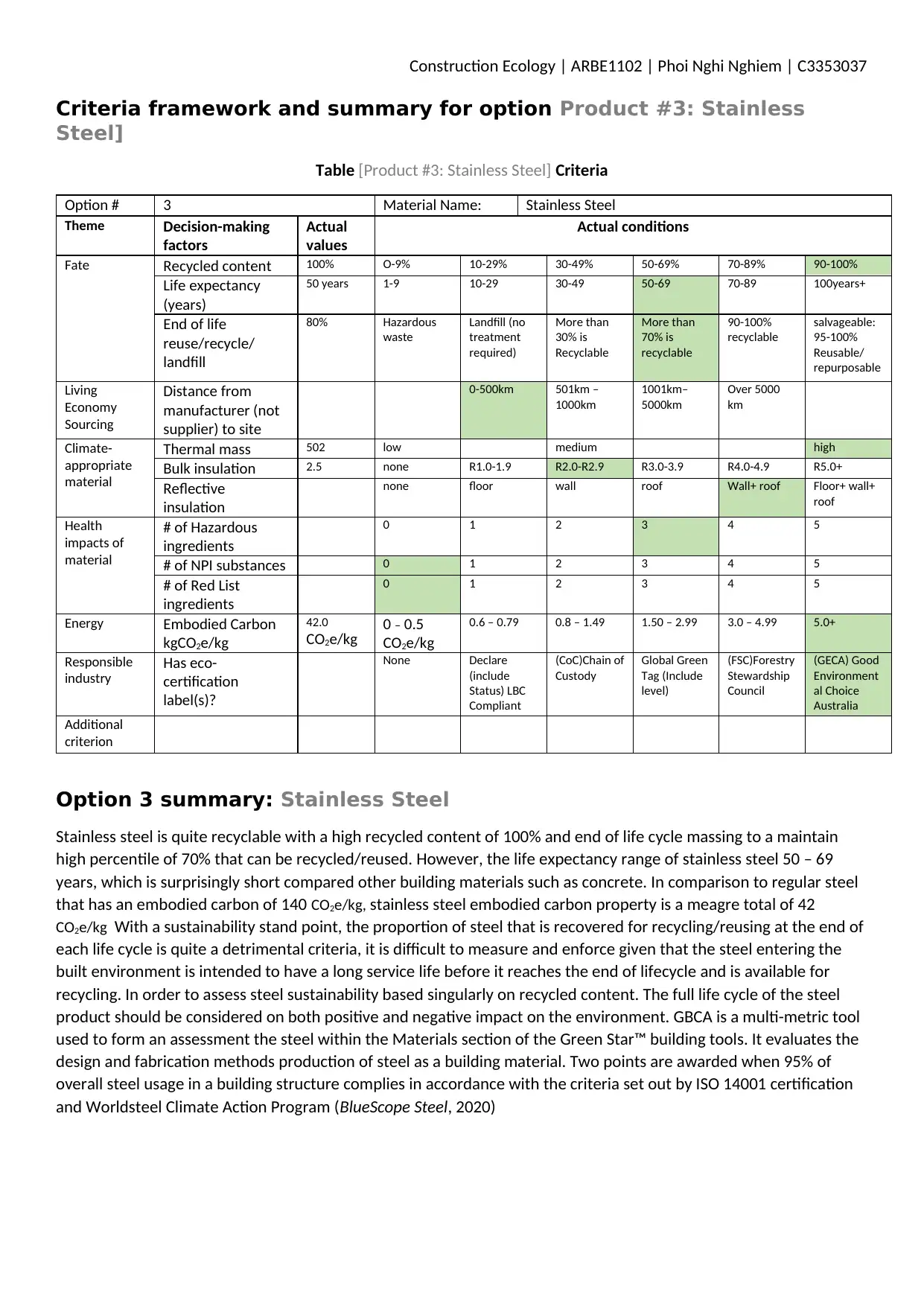
Construction Ecology | ARBE1102 | Phoi Nghi Nghiem | C3353037
Criteria framework and summary for option Product #3: Stainless
Steel]
Table [Product #3: Stainless Steel] Criteria
Option # 3 Material Name: Stainless Steel
Theme Decision-making
factors
Actual
values
Actual conditions
Fate Recycled content 100% O-9% 10-29% 30-49% 50-69% 70-89% 90-100%
Life expectancy
(years)
50 years 1-9 10-29 30-49 50-69 70-89 100years+
End of life
reuse/recycle/
landfill
80% Hazardous
waste
Landfill (no
treatment
required)
More than
30% is
Recyclable
More than
70% is
recyclable
90-100%
recyclable
salvageable:
95-100%
Reusable/
repurposable
Living
Economy
Sourcing
Distance from
manufacturer (not
supplier) to site
0-500km 501km –
1000km
1001km–
5000km
Over 5000
km
Climate-
appropriate
material
Thermal mass 502 low medium high
Bulk insulation 2.5 none R1.0-1.9 R2.0-R2.9 R3.0-3.9 R4.0-4.9 R5.0+
Reflective
insulation
none floor wall roof Wall+ roof Floor+ wall+
roof
Health
impacts of
material
# of Hazardous
ingredients
0 1 2 3 4 5
# of NPI substances 0 1 2 3 4 5
# of Red List
ingredients
0 1 2 3 4 5
Energy Embodied Carbon
kgCO2e/kg
42.0
CO2e/kg 0 – 0.5
CO2e/kg
0.6 – 0.79 0.8 – 1.49 1.50 – 2.99 3.0 – 4.99 5.0+
Responsible
industry
Has eco-
certification
label(s)?
None Declare
(include
Status) LBC
Compliant
(CoC)Chain of
Custody
Global Green
Tag (Include
level)
(FSC)Forestry
Stewardship
Council
(GECA) Good
Environment
al Choice
Australia
Additional
criterion
Option 3 summary: Stainless Steel
Stainless steel is quite recyclable with a high recycled content of 100% and end of life cycle massing to a maintain
high percentile of 70% that can be recycled/reused. However, the life expectancy range of stainless steel 50 – 69
years, which is surprisingly short compared other building materials such as concrete. In comparison to regular steel
that has an embodied carbon of 140 CO2e/kg, stainless steel embodied carbon property is a meagre total of 42
CO2e/kg With a sustainability stand point, the proportion of steel that is recovered for recycling/reusing at the end of
each life cycle is quite a detrimental criteria, it is difficult to measure and enforce given that the steel entering the
built environment is intended to have a long service life before it reaches the end of lifecycle and is available for
recycling. In order to assess steel sustainability based singularly on recycled content. The full life cycle of the steel
product should be considered on both positive and negative impact on the environment. GBCA is a multi-metric tool
used to form an assessment the steel within the Materials section of the Green Star™ building tools. It evaluates the
design and fabrication methods production of steel as a building material. Two points are awarded when 95% of
overall steel usage in a building structure complies in accordance with the criteria set out by ISO 14001 certification
and Worldsteel Climate Action Program (BlueScope Steel, 2020)
Criteria framework and summary for option Product #3: Stainless
Steel]
Table [Product #3: Stainless Steel] Criteria
Option # 3 Material Name: Stainless Steel
Theme Decision-making
factors
Actual
values
Actual conditions
Fate Recycled content 100% O-9% 10-29% 30-49% 50-69% 70-89% 90-100%
Life expectancy
(years)
50 years 1-9 10-29 30-49 50-69 70-89 100years+
End of life
reuse/recycle/
landfill
80% Hazardous
waste
Landfill (no
treatment
required)
More than
30% is
Recyclable
More than
70% is
recyclable
90-100%
recyclable
salvageable:
95-100%
Reusable/
repurposable
Living
Economy
Sourcing
Distance from
manufacturer (not
supplier) to site
0-500km 501km –
1000km
1001km–
5000km
Over 5000
km
Climate-
appropriate
material
Thermal mass 502 low medium high
Bulk insulation 2.5 none R1.0-1.9 R2.0-R2.9 R3.0-3.9 R4.0-4.9 R5.0+
Reflective
insulation
none floor wall roof Wall+ roof Floor+ wall+
roof
Health
impacts of
material
# of Hazardous
ingredients
0 1 2 3 4 5
# of NPI substances 0 1 2 3 4 5
# of Red List
ingredients
0 1 2 3 4 5
Energy Embodied Carbon
kgCO2e/kg
42.0
CO2e/kg 0 – 0.5
CO2e/kg
0.6 – 0.79 0.8 – 1.49 1.50 – 2.99 3.0 – 4.99 5.0+
Responsible
industry
Has eco-
certification
label(s)?
None Declare
(include
Status) LBC
Compliant
(CoC)Chain of
Custody
Global Green
Tag (Include
level)
(FSC)Forestry
Stewardship
Council
(GECA) Good
Environment
al Choice
Australia
Additional
criterion
Option 3 summary: Stainless Steel
Stainless steel is quite recyclable with a high recycled content of 100% and end of life cycle massing to a maintain
high percentile of 70% that can be recycled/reused. However, the life expectancy range of stainless steel 50 – 69
years, which is surprisingly short compared other building materials such as concrete. In comparison to regular steel
that has an embodied carbon of 140 CO2e/kg, stainless steel embodied carbon property is a meagre total of 42
CO2e/kg With a sustainability stand point, the proportion of steel that is recovered for recycling/reusing at the end of
each life cycle is quite a detrimental criteria, it is difficult to measure and enforce given that the steel entering the
built environment is intended to have a long service life before it reaches the end of lifecycle and is available for
recycling. In order to assess steel sustainability based singularly on recycled content. The full life cycle of the steel
product should be considered on both positive and negative impact on the environment. GBCA is a multi-metric tool
used to form an assessment the steel within the Materials section of the Green Star™ building tools. It evaluates the
design and fabrication methods production of steel as a building material. Two points are awarded when 95% of
overall steel usage in a building structure complies in accordance with the criteria set out by ISO 14001 certification
and Worldsteel Climate Action Program (BlueScope Steel, 2020)
⊘ This is a preview!⊘
Do you want full access?
Subscribe today to unlock all pages.

Trusted by 1+ million students worldwide
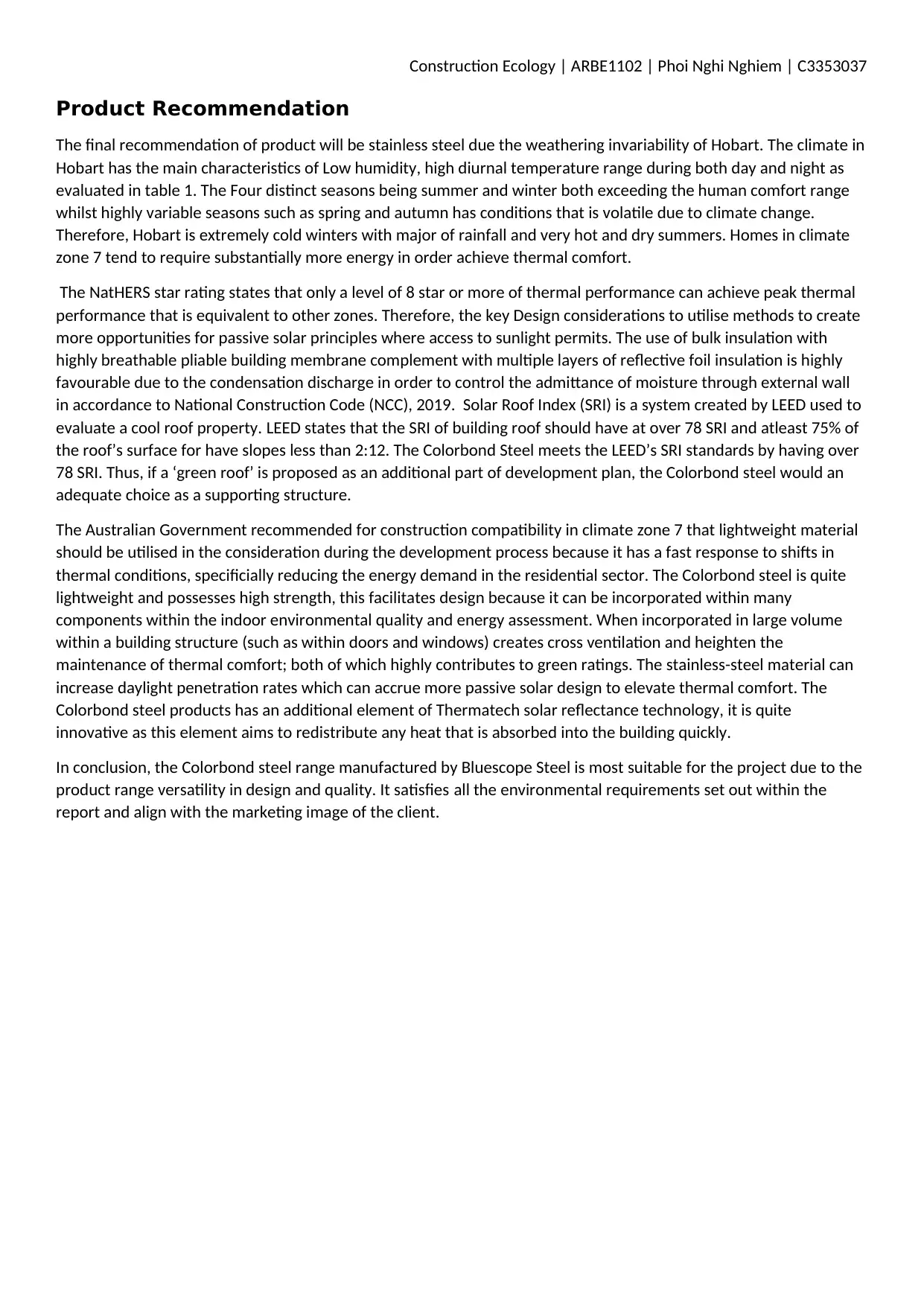
Construction Ecology | ARBE1102 | Phoi Nghi Nghiem | C3353037
Product Recommendation
The final recommendation of product will be stainless steel due the weathering invariability of Hobart. The climate in
Hobart has the main characteristics of Low humidity, high diurnal temperature range during both day and night as
evaluated in table 1. The Four distinct seasons being summer and winter both exceeding the human comfort range
whilst highly variable seasons such as spring and autumn has conditions that is volatile due to climate change.
Therefore, Hobart is extremely cold winters with major of rainfall and very hot and dry summers. Homes in climate
zone 7 tend to require substantially more energy in order achieve thermal comfort.
The NatHERS star rating states that only a level of 8 star or more of thermal performance can achieve peak thermal
performance that is equivalent to other zones. Therefore, the key Design considerations to utilise methods to create
more opportunities for passive solar principles where access to sunlight permits. The use of bulk insulation with
highly breathable pliable building membrane complement with multiple layers of reflective foil insulation is highly
favourable due to the condensation discharge in order to control the admittance of moisture through external wall
in accordance to National Construction Code (NCC), 2019. Solar Roof Index (SRI) is a system created by LEED used to
evaluate a cool roof property. LEED states that the SRI of building roof should have at over 78 SRI and atleast 75% of
the roof’s surface for have slopes less than 2:12. The Colorbond Steel meets the LEED’s SRI standards by having over
78 SRI. Thus, if a ‘green roof’ is proposed as an additional part of development plan, the Colorbond steel would an
adequate choice as a supporting structure.
The Australian Government recommended for construction compatibility in climate zone 7 that lightweight material
should be utilised in the consideration during the development process because it has a fast response to shifts in
thermal conditions, specificially reducing the energy demand in the residential sector. The Colorbond steel is quite
lightweight and possesses high strength, this facilitates design because it can be incorporated within many
components within the indoor environmental quality and energy assessment. When incorporated in large volume
within a building structure (such as within doors and windows) creates cross ventilation and heighten the
maintenance of thermal comfort; both of which highly contributes to green ratings. The stainless-steel material can
increase daylight penetration rates which can accrue more passive solar design to elevate thermal comfort. The
Colorbond steel products has an additional element of Thermatech solar reflectance technology, it is quite
innovative as this element aims to redistribute any heat that is absorbed into the building quickly.
In conclusion, the Colorbond steel range manufactured by Bluescope Steel is most suitable for the project due to the
product range versatility in design and quality. It satisfies all the environmental requirements set out within the
report and align with the marketing image of the client.
Product Recommendation
The final recommendation of product will be stainless steel due the weathering invariability of Hobart. The climate in
Hobart has the main characteristics of Low humidity, high diurnal temperature range during both day and night as
evaluated in table 1. The Four distinct seasons being summer and winter both exceeding the human comfort range
whilst highly variable seasons such as spring and autumn has conditions that is volatile due to climate change.
Therefore, Hobart is extremely cold winters with major of rainfall and very hot and dry summers. Homes in climate
zone 7 tend to require substantially more energy in order achieve thermal comfort.
The NatHERS star rating states that only a level of 8 star or more of thermal performance can achieve peak thermal
performance that is equivalent to other zones. Therefore, the key Design considerations to utilise methods to create
more opportunities for passive solar principles where access to sunlight permits. The use of bulk insulation with
highly breathable pliable building membrane complement with multiple layers of reflective foil insulation is highly
favourable due to the condensation discharge in order to control the admittance of moisture through external wall
in accordance to National Construction Code (NCC), 2019. Solar Roof Index (SRI) is a system created by LEED used to
evaluate a cool roof property. LEED states that the SRI of building roof should have at over 78 SRI and atleast 75% of
the roof’s surface for have slopes less than 2:12. The Colorbond Steel meets the LEED’s SRI standards by having over
78 SRI. Thus, if a ‘green roof’ is proposed as an additional part of development plan, the Colorbond steel would an
adequate choice as a supporting structure.
The Australian Government recommended for construction compatibility in climate zone 7 that lightweight material
should be utilised in the consideration during the development process because it has a fast response to shifts in
thermal conditions, specificially reducing the energy demand in the residential sector. The Colorbond steel is quite
lightweight and possesses high strength, this facilitates design because it can be incorporated within many
components within the indoor environmental quality and energy assessment. When incorporated in large volume
within a building structure (such as within doors and windows) creates cross ventilation and heighten the
maintenance of thermal comfort; both of which highly contributes to green ratings. The stainless-steel material can
increase daylight penetration rates which can accrue more passive solar design to elevate thermal comfort. The
Colorbond steel products has an additional element of Thermatech solar reflectance technology, it is quite
innovative as this element aims to redistribute any heat that is absorbed into the building quickly.
In conclusion, the Colorbond steel range manufactured by Bluescope Steel is most suitable for the project due to the
product range versatility in design and quality. It satisfies all the environmental requirements set out within the
report and align with the marketing image of the client.
Paraphrase This Document
Need a fresh take? Get an instant paraphrase of this document with our AI Paraphraser
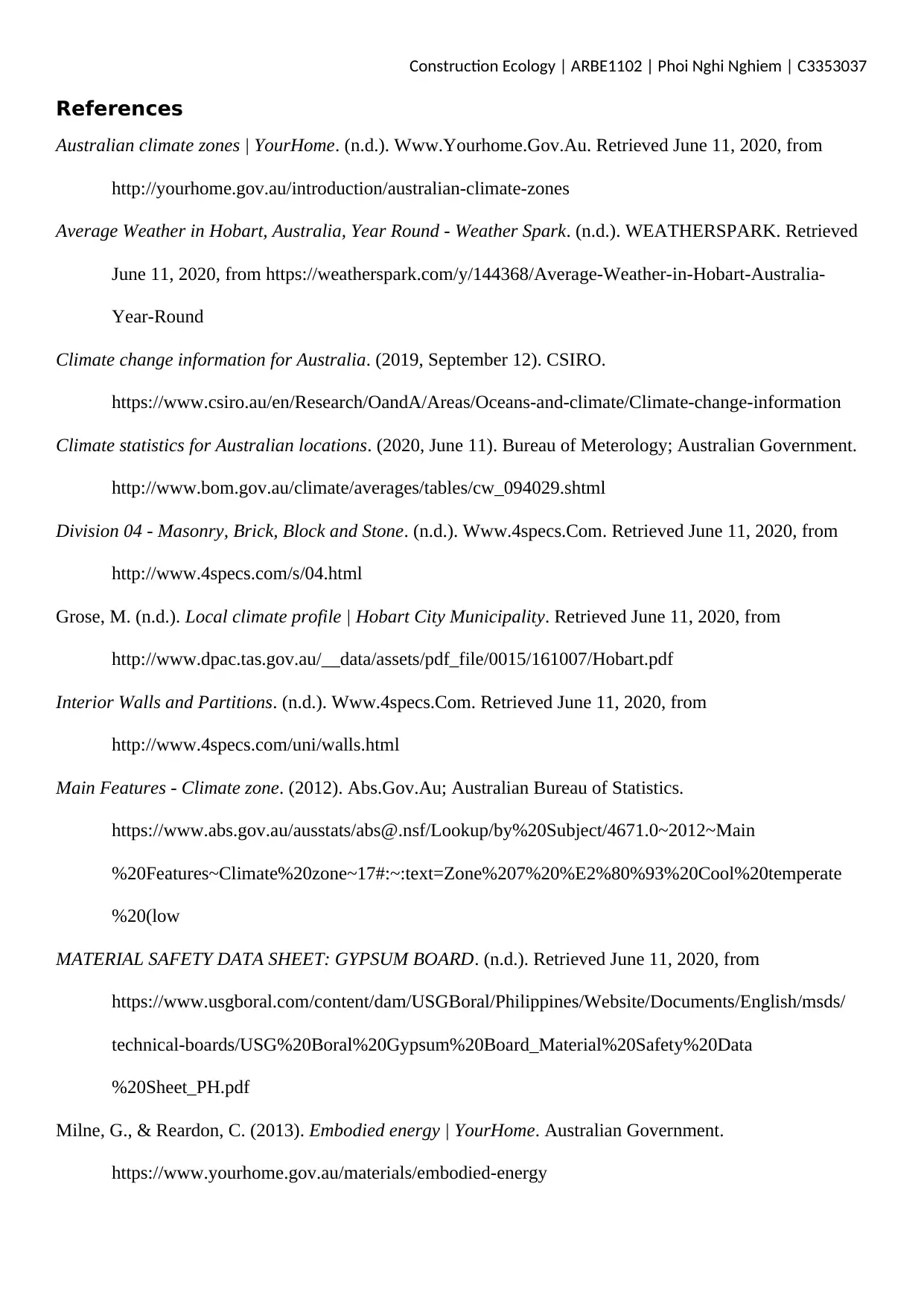
Construction Ecology | ARBE1102 | Phoi Nghi Nghiem | C3353037
References
Australian climate zones | YourHome. (n.d.). Www.Yourhome.Gov.Au. Retrieved June 11, 2020, from
http://yourhome.gov.au/introduction/australian-climate-zones
Average Weather in Hobart, Australia, Year Round - Weather Spark. (n.d.). WEATHERSPARK. Retrieved
June 11, 2020, from https://weatherspark.com/y/144368/Average-Weather-in-Hobart-Australia-
Year-Round
Climate change information for Australia. (2019, September 12). CSIRO.
https://www.csiro.au/en/Research/OandA/Areas/Oceans-and-climate/Climate-change-information
Climate statistics for Australian locations. (2020, June 11). Bureau of Meterology; Australian Government.
http://www.bom.gov.au/climate/averages/tables/cw_094029.shtml
Division 04 - Masonry, Brick, Block and Stone. (n.d.). Www.4specs.Com. Retrieved June 11, 2020, from
http://www.4specs.com/s/04.html
Grose, M. (n.d.). Local climate profile | Hobart City Municipality. Retrieved June 11, 2020, from
http://www.dpac.tas.gov.au/__data/assets/pdf_file/0015/161007/Hobart.pdf
Interior Walls and Partitions. (n.d.). Www.4specs.Com. Retrieved June 11, 2020, from
http://www.4specs.com/uni/walls.html
Main Features - Climate zone. (2012). Abs.Gov.Au; Australian Bureau of Statistics.
https://www.abs.gov.au/ausstats/abs@.nsf/Lookup/by%20Subject/4671.0~2012~Main
%20Features~Climate%20zone~17#:~:text=Zone%207%20%E2%80%93%20Cool%20temperate
%20(low
MATERIAL SAFETY DATA SHEET: GYPSUM BOARD. (n.d.). Retrieved June 11, 2020, from
https://www.usgboral.com/content/dam/USGBoral/Philippines/Website/Documents/English/msds/
technical-boards/USG%20Boral%20Gypsum%20Board_Material%20Safety%20Data
%20Sheet_PH.pdf
Milne, G., & Reardon, C. (2013). Embodied energy | YourHome. Australian Government.
https://www.yourhome.gov.au/materials/embodied-energy
References
Australian climate zones | YourHome. (n.d.). Www.Yourhome.Gov.Au. Retrieved June 11, 2020, from
http://yourhome.gov.au/introduction/australian-climate-zones
Average Weather in Hobart, Australia, Year Round - Weather Spark. (n.d.). WEATHERSPARK. Retrieved
June 11, 2020, from https://weatherspark.com/y/144368/Average-Weather-in-Hobart-Australia-
Year-Round
Climate change information for Australia. (2019, September 12). CSIRO.
https://www.csiro.au/en/Research/OandA/Areas/Oceans-and-climate/Climate-change-information
Climate statistics for Australian locations. (2020, June 11). Bureau of Meterology; Australian Government.
http://www.bom.gov.au/climate/averages/tables/cw_094029.shtml
Division 04 - Masonry, Brick, Block and Stone. (n.d.). Www.4specs.Com. Retrieved June 11, 2020, from
http://www.4specs.com/s/04.html
Grose, M. (n.d.). Local climate profile | Hobart City Municipality. Retrieved June 11, 2020, from
http://www.dpac.tas.gov.au/__data/assets/pdf_file/0015/161007/Hobart.pdf
Interior Walls and Partitions. (n.d.). Www.4specs.Com. Retrieved June 11, 2020, from
http://www.4specs.com/uni/walls.html
Main Features - Climate zone. (2012). Abs.Gov.Au; Australian Bureau of Statistics.
https://www.abs.gov.au/ausstats/abs@.nsf/Lookup/by%20Subject/4671.0~2012~Main
%20Features~Climate%20zone~17#:~:text=Zone%207%20%E2%80%93%20Cool%20temperate
%20(low
MATERIAL SAFETY DATA SHEET: GYPSUM BOARD. (n.d.). Retrieved June 11, 2020, from
https://www.usgboral.com/content/dam/USGBoral/Philippines/Website/Documents/English/msds/
technical-boards/USG%20Boral%20Gypsum%20Board_Material%20Safety%20Data
%20Sheet_PH.pdf
Milne, G., & Reardon, C. (2013). Embodied energy | YourHome. Australian Government.
https://www.yourhome.gov.au/materials/embodied-energy
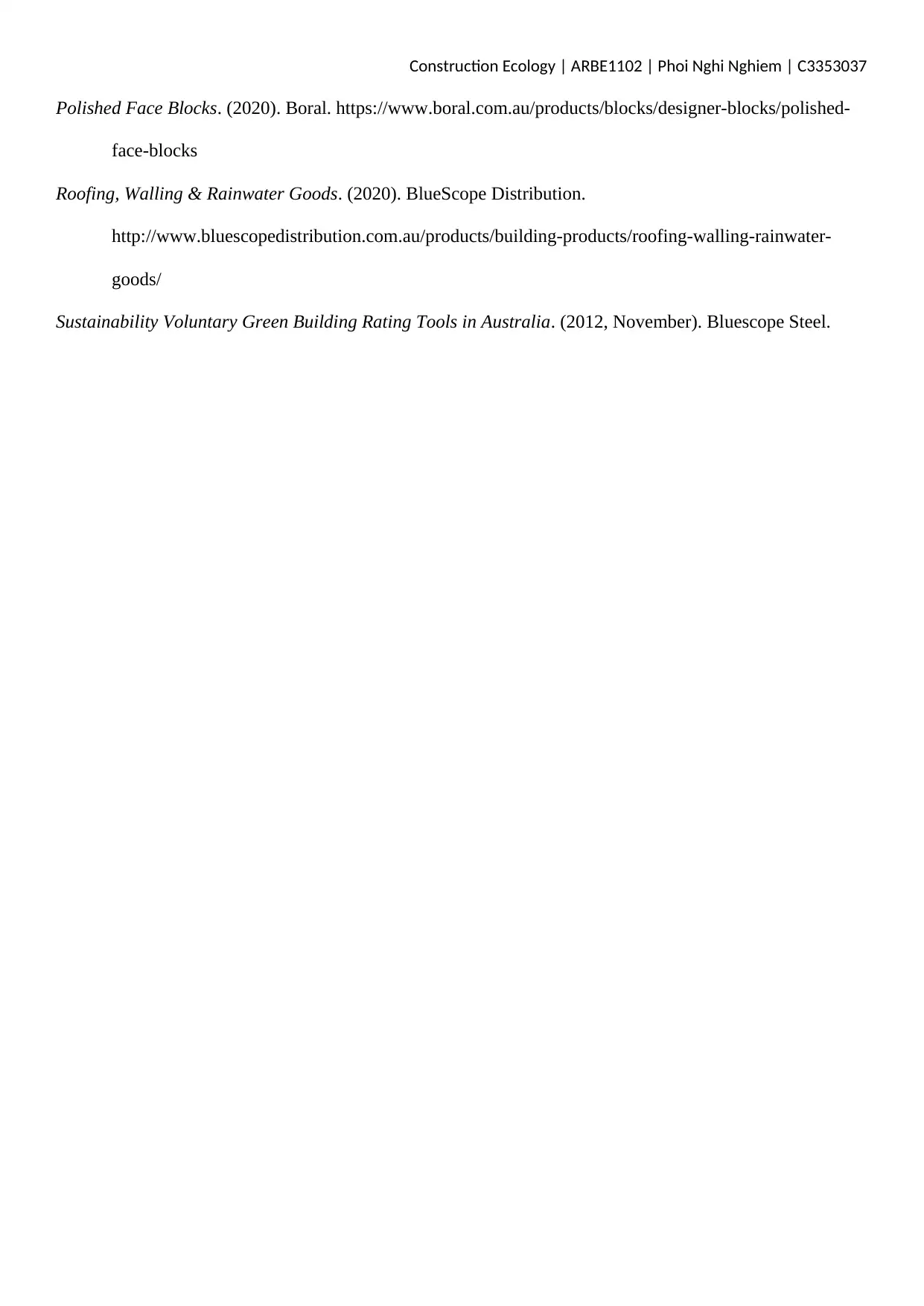
Construction Ecology | ARBE1102 | Phoi Nghi Nghiem | C3353037
Polished Face Blocks. (2020). Boral. https://www.boral.com.au/products/blocks/designer-blocks/polished-
face-blocks
Roofing, Walling & Rainwater Goods. (2020). BlueScope Distribution.
http://www.bluescopedistribution.com.au/products/building-products/roofing-walling-rainwater-
goods/
Sustainability Voluntary Green Building Rating Tools in Australia. (2012, November). Bluescope Steel.
Polished Face Blocks. (2020). Boral. https://www.boral.com.au/products/blocks/designer-blocks/polished-
face-blocks
Roofing, Walling & Rainwater Goods. (2020). BlueScope Distribution.
http://www.bluescopedistribution.com.au/products/building-products/roofing-walling-rainwater-
goods/
Sustainability Voluntary Green Building Rating Tools in Australia. (2012, November). Bluescope Steel.
⊘ This is a preview!⊘
Do you want full access?
Subscribe today to unlock all pages.

Trusted by 1+ million students worldwide
1 out of 12
Related Documents
Your All-in-One AI-Powered Toolkit for Academic Success.
+13062052269
info@desklib.com
Available 24*7 on WhatsApp / Email
![[object Object]](/_next/static/media/star-bottom.7253800d.svg)
Unlock your academic potential
Copyright © 2020–2025 A2Z Services. All Rights Reserved. Developed and managed by ZUCOL.



